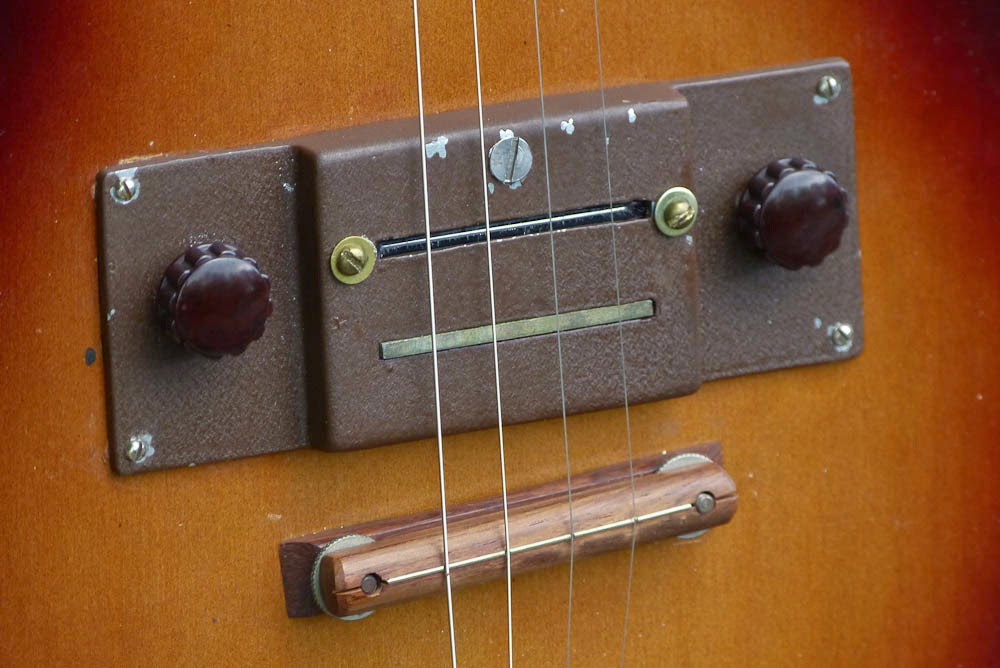c.1940 Regal Electric Tenor Guitar
I decided to update this entire blog post since I've made some alterations since I last posted this to make this a much more functional instrument. For starters, though, this is a mid-30s or early-40s Regal electric tenor guitar and sports the Regal-specific cast pickup housing that one sees on many Regal-branded lap steels and early electric products from the same time. The guitar itself uses the outline of Regal's "squashed 000" shape which seems to have been in reaction to Kalamazoo KG-11 looks and styling.
My work on this guy included a neck reset, brace and seam repairs, a fret level/dress, new tuners, and in the end installation of a replacement pickup (the original was just too low-output to be useful in any sort of modern context and this seems to be common to the original pickup type). It's now got a new Bill Lawrence blade-style humbucking Strat pickup installed in place of the original blade pup. The wiring harness is also entirely new though I re-used the original bakelite knobs. I kept the same reverse-functioning tone control layout, though, for fun. I would've preferred to install two of these in place of both "blades" of the original housing but there's a rather large "bump" that disallows that for the rear blade (which is just a "dummy" now).
The bottom line? It plays great and has a practical sound with a distinctly vintage, almost "archtop electric" vibe going on. It's fun!
The top is thick plywood but the rest of the instrument is solid woods including a maple neck and birch back/sides.
Original bone nut, tuner ferrules, and cool Regal "shield" headstock shape.
Pearl dots in a dyed-maple board. The neck has a big old 1 3/8" width at the nut and a fairly deep back. This is pretty big for a tenor guitar and it actually feels pretty great because there's a lot more room to move around than usual.
This tenor also has an odd 24 1/4" scale length which makes it not very useful for "standard" CGDA tuning but very very useful for guitar-style DGBE ("Chicago") tuning and also mandolin-centric "octave mandolin/Celtic" GDAE tuning. The strings currently on this do a nice light-tension GDAE.
Here you can see that Lawrence blade pickup mounted in the "upper" slot. I ground down the ends and covered them off so that the blade didn't come in contact with the metal pickup housing. This improves clarity and output though with all of that metal around it the tone is definitely altered compared to if this pickup were simply in the middle or bridge position on, say, a Stratocaster or Tele.
The bridge is adjustable and while it's not intonated 100% as-is I can certainly intonate it per a customer's request for a specific tuning or stringing.
See that bolt head clear as day in the middle of the back...?
So, here's something intriguing: this guitar originally came equipped with 4 "soundpost" blocks that ran under the pickup housing from the top to the back presumably to mostly eliminate feedback from a top that moved too freely. Their structural role was questionabl because the whole thing is overbuilt with plenty of ladder braces on the top and back and a very thick ply top that probably doesn't need any bracing at all to withstand string tension. For the last "who-knows-how-long?" they were also all loose on the inside, anyhow.
At any rate, I ran into a problem after a couple days where, under tension now with strings, the geometry of the instrument changed and it became apparent that the "soundpost" blocks were sort of shoving the top up just very very slightly to the point where it was somewhat easy to "buzz out" the strings when playing past the 17th fret... they were simply buzzing on the pickup housing itself when struck hard with a pick.
So... I removed the sound posts... strung it up... somewhat better... but I wanted the ability to correct this... so... a dumb-as-nails approach meant I installed a couple bolts -- one going through the (now-modified-anyhow) pickup housing and one going through and supported by a big "patch/strapping" brace on the back and joined with a coupler nut in the middle. By applying a small amount of tension I was able to "pull" the top back into the place where I wanted it to be and the couplers act as the "feedback eliminator" that the soundposts were supposed to be anyway.
It's not ideal but not much is ideal on some of these old rushed-to-production early electric products. They were still ironing out kinks in pure hollowbody electric design and sometimes you just have to sit down and make lemonade!
Repro Kluson-style tuners replaced original Klusons that were deteriorating. The originals are tucked safely in the case.
The tailpiece needed moving over just a bit to keep it on centerline with the neck. It was a bit off when first had it in, too.
The original chip case is in decent shape but could use some stitching/duct tape along one top edge. Cool plush interior though, huh?

















Comments